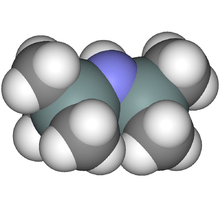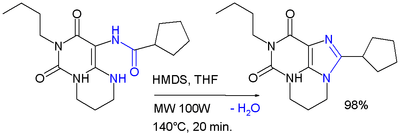Bis(trimethylsilyl)amine
Bis(trimethylsilyl)amine (also known as hexamethyldisilazane and HMDS) is an organosilicon compound with the molecular formula [(CH3)3Si]2NH. The molecule is a derivative of ammonia with trimethylsilyl groups in place of two hydrogen atoms. An electron diffraction study shows that silicon-nitrogen bond length (173.5 pm) and Si-N-Si bond angle (125.5°) to be similar to disilazane (in which methyl groups are replaced by hydrogen atoms) suggesting that steric factors are not a factor in regulating angles in this case.[2] This colorless liquid is a reagent and a precursor to bases that are popular in organic synthesis and organometallic chemistry. Additionally, HMDS is also increasingly used as molecular precursor in chemical vapor deposition techniques to deposit silicon carbonitride thin films or coatings.
| |||
| Names | |||
|---|---|---|---|
| Preferred IUPAC name
1,1,1-Trimethyl-N-(trimethylsilyl)silanamine[1] | |||
| Other names
Bis(trimethylsilyl)azane Bis(trimethylsilyl)amine 1,1,1,3,3,3-Hexamethyldisilazane Hexamethyldisilazane | |||
| Identifiers | |||
3D model (JSmol) |
|||
| Abbreviations | HMDS | ||
| 635752 | |||
| ChEBI | |||
| ChemSpider | |||
| ECHA InfoCard | 100.012.425 | ||
| EC Number |
| ||
| MeSH | Hexamethylsilazane | ||
PubChem CID |
|||
| RTECS number |
| ||
| UNII | |||
| UN number | 2924, 3286 | ||
CompTox Dashboard (EPA) |
|||
| |||
| |||
| Properties | |||
| C6H19NSi2 | |||
| Molar mass | 161.395 g·mol−1 | ||
| Appearance | Colorless liquid | ||
| Density | 0.77 g cm−3 | ||
| Melting point | −78 °C (−108 °F; 195 K) | ||
| Boiling point | 126 °C (259 °F; 399 K) | ||
| Slow hydrolysis | |||
Refractive index (nD) |
1.4080 | ||
| Hazards | |||
| Safety data sheet | External MSDS | ||
| NFPA 704 (fire diamond) | |||
Except where otherwise noted, data are given for materials in their standard state (at 25 °C [77 °F], 100 kPa). | |||
| Infobox references | |||
Synthesis and derivatives
Bis(trimethylsilyl)amine is synthesized by treatment of trimethylsilyl chloride with ammonia:[3]
- 2 (CH3)3SiCl + 3 NH3 → [(CH3)3Si]2NH + 2 NH4Cl
Ammonium nitrate together with triethylamine can be used instead.[4] This method is also useful for 15N isotopic enrichment of HMDS.

Alkali metal bis(trimethylsilyl)amides result from the deprotonation of bis(trimethylsilyl)amine. For example, lithium bis(trimethylsilyl)amide (LiHMDS) is prepared using n-butyllithium:
- [(CH3)3Si]2NH + BuLi → [(CH3)3Si]2NLi + BuH
LiHMDS and other similar derivatives: sodium bis(trimethylsilyl)amide (NaHMDS) and potassium bis(trimethylsilyl)amide (KHMDS) are used as a non-nucleophilic bases in synthetic organic chemistry.
Use as reagent
Hexamethyldisilazane is employed as a reagent in many organic reactions.
1) HMDS is used as a reagent in condensation reactions of heterocyclic compounds such as in the microwave synthesis of a derivative of xanthine:[5]
2) The HMDS mediated trimethylsilylation of alcohols, thiols, amines and amino acids as protective groups or for intermediary organosilicon compounds is found to be very efficient and replaced TMSCl reagent.[6]
Silylation of glutamic acid with excess hexamethyldisilazane and catalytic TMSCl in either refluxing xylene or acetonitrile followed by dilution with alcohol (methanol or ethanol) yields the derived lactam pyroglutamic acid in good yield.

HMDS in the presence of catalytic iodine facilitates the silylation of alcohols in excellent yields.

3) HMDS can be used to silylate laboratory glassware and make it hydrophobic, or automobile glass, just as Rain-X does.
4) In gas chromatography, HMDS can be used to silylate OH groups of organic compounds to increase volatility, this way enabling GC-analysis of chemicals that are otherwise non-volatile.
Other uses
In photolithography, HMDS is often used as an adhesion promoter for photoresists. Best results are obtained by applying HMDS from the gas phase on heated substrates.[7]
In electron microscopy, HMDS can be used as an alternative to critical point drying during sample preparation.[8]
In pyrolysis-gas chromatography-mass spectrometry, HMDS is added to the analyte to create silylated diagnostic products during pyrolysis, in order to enhance detectability of compounds with polar functional groups.[9]
In plasma-enhanced chemical vapor deposition (PECVD), HMDS is used as a molecular precursor as a replacement to highly flammable and corrosive gasses like SiH4, CH4, NH3 as it can be easily handled. HMDS is used in conjunction with plasma (physics) of various gases such as argon, helium and nitrogen to deposit SiCN thin films/coatings with excellent mechanical, optical and electronic properties.[10]
References
- Nomenclature of Organic Chemistry : IUPAC Recommendations and Preferred Names 2013 (Blue Book). Cambridge: The Royal Society of Chemistry. 2014. p. 135. doi:10.1039/9781849733069-FP001. ISBN 978-0-85404-182-4.
- D.A. Armitage (1982). "Organosilicon - an overview". Comprehensive Organometallic Chemistry: 1–203. doi:10.1016/B978-008046518-0.00014-3.
- Robert C. Osthoff; Simon W. Kantor (1957). Organosilazane Compounds. Inorg. Synth. Inorganic Syntheses. 5. pp. 55–64. doi:10.1002/9780470132364.ch16. ISBN 978-0-470-13236-4.
- S.V. Chernyak; Yu. G. Yatluk; A.L. Suvorov (2000). "A Simple Synthesis of Hexamethyldisilazane (Translated from Zhurnal obshcheĭ khimiĭ, Vol. 70. No. 8, 2000. p1401)". Russian Journal of General Chemistry. 70: 1313.
- Burbiel JC, Hockemeyer J, Müller CE (2006). "Microwave-assisted ring closure reactions: Synthesis of 8-substituted xanthine derivatives and related pyrimido- and diazepinopurinediones". Beilstein J Org Chem. 2: 20. doi:10.1186/1860-5397-2-20. PMC 1698928. PMID 17067400.
- Benjamin A. Anderson; Vikas Sikervar (2001). "Hexamethyldisilazane". Encyclopedia of Reagents for Organic Synthesis. doi:10.1002/047084289X.rh016. ISBN 0471936235.
- Cornell NanoScale Science & Technology Facility. "CNF - Photolithography Resist Processes and Capabilities". Retrieved 2008-01-29.
- Bray DF, Bagu J, Koegler P (1993). "Comparison of hexamethyldisilazane (HMDS), Peldri II, and critical-point drying methods for scanning electron microscopy of biological specimens". Microsc. Res. Tech. 26 (6): 489–95. doi:10.1002/jemt.1070260603. PMID 8305726.
- Giuseppe Chiavari; Daniele Fabbri & Silvia Prati (2001). "Gas chromatographic–mass spectrometric analysis of products arising from pyrolysis of amino acids in the presence of hexamethyldisilazane". Journal of Chromatography A. 922 (1–2): 235–241. doi:10.1016/S0021-9673(01)00936-0. PMID 11486868.
- P. Jedrzejowski; J. Cizek; A. Amassian; J. E. Klemberg-Sapieha; J. Vlcek; L. Martinu (2004). "Mechanical and optical properties of hard SiCN coatings prepared by PECVD". Thin Solid Films . 447-448: 201–207. Bibcode:2004TSF...447..201J. doi:10.1016/S0040-6090(03)01057-5.



